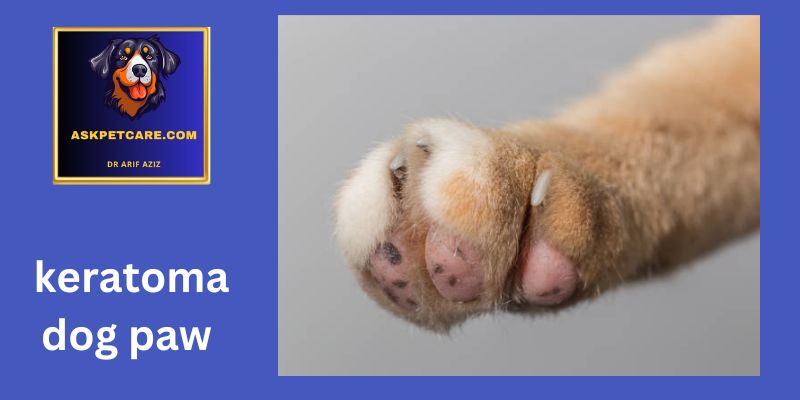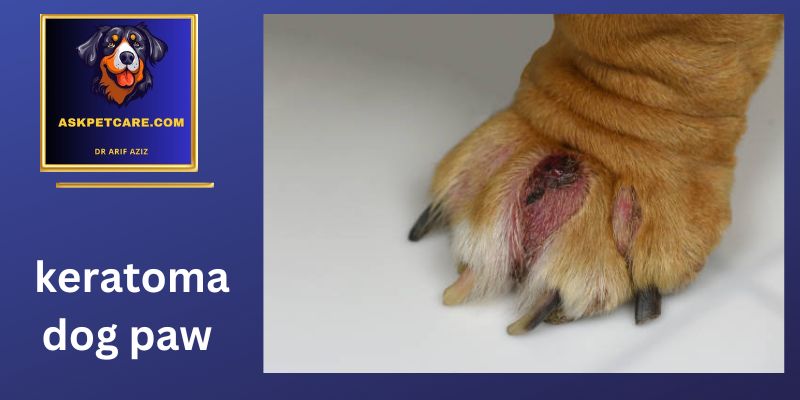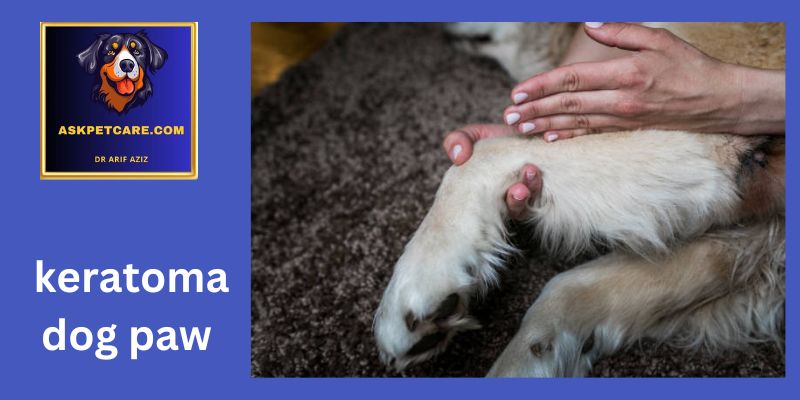Hello dog lovers I am Dr. Arif Aziz in this blog post Dog Paw Keratoma I will explain its different aspects like what is keratoma, its causes, signs and symptoms, and in the end its treatment which I performed at my clinic.
Paw pad keratoma is a condition that affects the pads of a dog’s paws, leading to the formation of abnormal growths or lesions comprised of keratinized tissue. Here’s a detailed explanation of each aspect:

Definition and Overview of Paw Pad Keratoma:
Paw pad keratoma refers to the development of keratinized tissue growths on the paw pads of dogs. Keratinization is a natural process where skin cells produce keratin, a tough protein that forms the outer layer of the skin. However, in the case of paw pad keratoma, this process becomes abnormal, leading to the formation of thickened, hardened growths on the pads of the paws.
Explanation of the Keratinized Tissue Buildup on the Paw Pads:
Keratinized tissue buildup occurs when there is an overproduction or abnormal accumulation of keratin in the skin cells of the paw pads. This can result from various factors, including genetic predisposition, chronic irritation or inflammation, trauma, or underlying medical conditions. As the keratinized tissue continues to accumulate, it forms raised, roughened areas on the paw pads, which can cause discomfort and affect the dog’s mobility.
Differentiating Between dog paw Keratomas and Other Paw Pad Conditions:
It’s essential to differentiate paw pad keratoma from other paw pad conditions to confirm accurate diagnosis and suitable treatment. Some key differences include:
Paw Pad Calluses:
Calluses are areas of thickened, hardened skin that develop over time as a result of repeated pressure or friction. While similar in appearance to keratomas, calluses typically occur on weight-bearing areas of the paw pads and are often benign. They may not cause discomfort unless they become excessively thick or irritated.
Paw Pad Hyperkeratosis:
Hyperkeratosis refers to the abnormal thickening of the skin due to increased keratin production. Unlike keratomas, which form discrete growths, hyperkeratosis affects larger areas of the paw pads and may be associated with underlying health conditions such as autoimmune disorders or nutritional deficiencies.
Paw Pad Tumors:
Paw pad tumors encompass a wide range of growths, including benign and malignant masses that can develop on the paw pads. While keratomas are benign growths composed of keratinized tissue, tumors may consist of various cell types and can have different clinical presentations. A biopsy or tissue sampling is often necessary to distinguish between benign and malignant paw pad lesions.
By understanding the characteristics and distinguishing features of paw pad keratomas, veterinarians can accurately diagnose the condition and recommend appropriate treatment options to alleviate discomfort and improve the dog’s quality of life
Now we understand the Causes of Paw Pad Keratoma:

Genetic Predisposition and Breed Tendencies
-
- Certain breeds may have a genetic tendency to develop paw pad keratomas.
- Genetics influence a dog’s vulnerability to various skin and paw pad conditions.
- Breeds with thickened or roughened paw pads may be more lying to keratoma development.
Trauma or Injury to the Paw Pads
-
- Activities such as running on rough surfaces or excessive jumping can cause micro trauma.
- Chronic exposure to abrasive surfaces can lead to inflammation and tissue damage.
- Trauma triggers the body’s protective response, resulting in the formation of keratinized growths.
Chronic Irritation or Inflammation from Foreign Objects
-
- Foreign objects lodged in the paw pads cause chronic irritation and inflammation.
- Debris, gravel, thorns, or splinters can become embedded, causing tissue damage.
- Excess keratin production occurs as a protective response to the foreign material.
Secondary to Other Medical Conditions such as Infections or Allergies
-
- Paw pad keratomas can develop as a secondary complication of infections.
- Bacterial, fungal, or parasitic infections disrupt normal skin function.
- Allergic reactions to environmental allergens or food ingredients can lead to inflammation.
Understanding these causes is vital for implementing preventive measures and addressing contributing factors to promote paw pad health and prevent the development of keratomas in dogs.
Now we discuss the Symptoms of Paw Pad Keratoma:
Thickening and Hardening of the Paw Pads
-
- Paw pads may appear thicker and harder than usual.
- The texture of the paw pads may feel rough or uneven to the touch.
Lameness or Limping, Especially During Physical Activity
-
- Dogs may show reluctance to walk, run, or engage in physical activity.
- Limping or choosing one or more limbs is common, especially after exercise or prolonged activity.
Discomfort or Pain When Walking or Standing
-
- Dogs may display signs of discomfort or pain when walking or standing for extended periods.
- Vocalizations such as whining or crying may indicate discomfort associated with paw pad keratoma.
Visible Signs of Inflammation or Swelling on the Paw Pads
-
- Paw pads may appear red, swollen, or inflamed.
- Increased sensitivity to touch or pressure may be observed.
- Excessive licking or chewing of the paw pads may exacerbate inflammation and discomfort.
These symptoms indicate the presence of paw pad keratoma and should prompt pet owners to seek veterinary evaluation and treatment.
Now we discuss the Diagnosis of Paw Pad Keratoma:
Physical Examination by a Veterinarian
-
- A veterinarian conducts a thorough examination of the dog’s paw pads.
- The veterinarian assesses the texture, thickness, and appearance of the paw pads.
- Any signs of inflammation, swelling, or discomfort are noted during the examination.
Biopsy or Tissue Sampling for Definitive Diagnosis
-
- In cases where the diagnosis is uncertain, a biopsy or tissue sampling may be recommended.
- A small sample of the affected paw pad tissue is collected for microscopic examination.
- Biopsy results can confirm the presence of keratinized tissue growth characteristic of paw pad keratoma.
Imaging Studies such as X-rays or Ultrasounds to Assess the Extent of the Condition
-
- Imaging studies may be performed to evaluate the extent of paw pad keratoma.
- X-rays can help identify underlying bone abnormalities or fractures associated with chronic trauma.
- Ultrasounds may be used to assess soft tissue changes and detect any abnormalities within the paw pads.
These diagnostic methods help veterinarians accurately identify paw pad keratoma and develop an appropriate treatment plan tailored to the individual needs of the dog
Now we understand the Treatment Options for Paw Pad Keratoma:

Conservative Management with Topical Treatments and Padding
-
- Application of topical medications to soften and moisturize the paw pads.
- Use of protective padding or bandages to reduce friction and pressure on the affected areas.
- Regular paw pad care and hygiene to prevent further irritation and promote healing.
Surgical Intervention to Remove the Keratinized Tissue
-
- Surgical excision of the keratinized tissue growths under general anesthesia.
- Removal of the affected paw pad lesions to lighten discomfort and restore paw pad function.
- Closure of the surgical site with sutures or wound dressings to facilitate healing.
Management of Underlying Causes such as Infections or Allergies
-
- Identification and treatment of underlying medical conditions contributing to paw pad keratoma.
- Administration of antibiotics or antifungal medications to address bacterial or fungal infections.
- Implementation of allergy management strategies such as dietary changes or allergen avoidance.
Rehabilitation and Follow-up Care to Monitor Recovery and Prevent Recurrence
-
- Post-operative care and rehabilitation to promote healing and mobility.
- Monitoring of paw pad health and regular veterinary check-ups to assess recovery progress.
- Implementation of preventive measures to reduce the risk of paw pad keratoma recurrence, including proper paw pad hygiene and environmental management.
These treatment options are tailored to the individual needs of the dog and may vary depending on the severity and underlying causes of paw pad keratoma.
If you want to learn more click below.
what-is-dog-paw-hyperkeratosis
hyperkeratosis-dog-pow-home-remedy
Here are preventive measures and living considerations for paw pad keratoma
Preventive Measures for Paw Pad Keratoma:
Regular Paw Pad keratoma Inspections and Grooming
-
- Routine examination of the paw pads for signs of abnormalities or lesions.
- Regular trimming of excess hair and nails to prevent accumulation of debris and irritation.
Avoiding Rough Land or Harsh Surfaces During Walks or Exercise
-
- Selecting suitable walking routes that minimize exposure to rough or abrasive surfaces.
- Using protective booties or paw wax to shield the paw pads during outdoor activities.
Providing Proper Nutrition and Supplementation for Paw Pad Health
-
- Offering a balanced diet rich in essential nutrients, including vitamins and minerals.
- Consideration of supplements such as omega-3 fatty acids to support skin and paw pad health.
Prompt Treatment of Any Injuries or Infections to Prevent Complications
-
- Immediate attention to any cuts, abrasions, or injuries to the paw pads.
- Prompt veterinary care and treatment of infections to prevent secondary complications.
Now discuss the Living with Paw Pad Keratoma:

Adapting the Home Environment to Accommodate the Dog’s Needs
-
- Providing comfortable resting areas with cushioned bedding to alleviate pressure on the paw pads.
- Removing hazards and obstacles that may pose a risk of injury or irritation to the affected paws.
Monitoring for Signs of Recurrence or Worsening Symptoms
-
- Regular observation of the paw pads for changes in texture, thickness, or appearance.
- Prompt reporting of any recurrence or worsening of symptoms to the veterinarian.
Maintaining Regular Veterinary Check-ups and Follow-up Appointments
-
- Scheduling routine veterinary examinations to monitor paw pad health and assess treatment outcomes.
- Collaboration with the veterinarian to develop a long-term management plan for paw pad keratoma.
These preventive measures and living considerations play a crucial role in managing paw pad keratoma and promoting the overall well-being of dogs affected by this condition.
Do Dog Corns Go Away on Their Own?
Dog corns, also known as canine corns or footpad corns, are hard, thickened areas that develop on a dog’s paw pads. They are often caused by friction or pressure from walking on hard surfaces. Dog corns do not typically go away on their own. They may persist or worsen over time if left untreated.
Here’s why dog corns usually don’t resolve on their own:
Persistent Pressure:
Dog corns develop due to consistent pressure and friction on the paw pads. If the dog continues to walk on hard surfaces or if the underlying cause of the corns is not addressed, they are unlikely to resolve spontaneously.
Lack of Self-Healing Mechanism:
Unlike some minor injuries or abrasions that the body can naturally heal over time, dog corns involve thickened, hardened tissue that requires intervention to effectively address.
Underlying Causes:
Dog corns can be symptomatic of underlying issues such as allergies, infections, or anatomical abnormalities. Simply waiting for corns to disappear on their own may not address these root causes.

Is Keratosis Painful in Dogs?
Yes, it is painful. Keratosis refers to the excessive production or buildup of keratin, a tough protein found in the skin, hair, and nails. In dogs, keratosis can manifest as various skin conditions, including hyperkeratosis, seborrheic keratosis, or keratotic plaques. Whether keratosis is painful for dogs depends on several factors:
Location and Severity:
Keratosis can occur on different parts of the body, including the paw pads, nose, ears, or skin folds. If the keratosis develops in areas subject to friction or pressure, such as the paw pads, it can cause discomfort or pain, especially when walking or standing.
Inflammation and Infection:
In some cases, keratosis may be associated with inflammation, infection, or underlying medical conditions such as allergies or autoimmune disorders. Inflammation and infection can exacerbate discomfort and contribute to pain and irritation.
Secondary Complications:
If left untreated, keratosis can lead to secondary complications such as fissures, cracks, or ulcerations in the skin. These complications can be painful and increase the risk of infection.
. In summary, while keratosis itself may not always be painful, it can lead to discomfort and complications, especially if left untreated or if associated with underlying medical conditions. I hope you will thoroughly understand about the dog paw kerotoma.Top of Form
Here are some reference books that are considered authoritative on the topic of dog care, including nail care:
- “The Complete Dog Owner’s Manual” by Dr. Bruce Fogle
- “The Ultimate Guide to Dog Care: Everything You Need to Know to Keep Your Dog Happy and Healthy” by Amy Marder and Andrew Luescher


Very good👍. Excellent work. Keep it up. Share your experience with dog lovers.